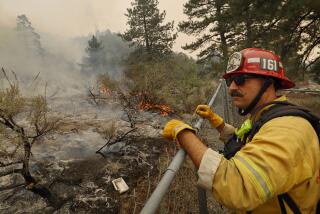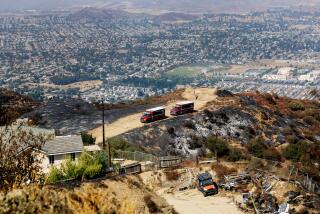Firefighters Hold the Line on Ojai Blaze
- Share via
Weary crews battled the Wolf fire near Ojai for the ninth day Sunday, allowing only a 55-acre growth in the blaze that has burned nearly 21,000 acres in Los Padres National Forest.
But their job is not over, as containment remained at 40% for a second day, and there is still no estimate on when the fire will be fully controlled.
Nearly 2,000 firefighters from a dozen county, state and federal agencies have attacked the blaze from land and air since it began June 1. More than 1,500 are fighting it now.
U.S. Forest Service officials had anticipated major progress in containing the wildfire after three straight days of milder temperatures and marine-layer moisture, but that did not materialize as of Sunday evening.
“Even though we are building a line, and we’re making progress, we’re not confident enough about whether the line will hold to be able to say we’re getting extra containment,” forest service spokesman Jim Turner said. “The remoteness is getting us there.”
Temperatures have hovered around 70 degrees in the rugged wilderness about 10 miles north of Ojai since Friday, with relative humidity ranging from 30% to 70%.
That was a welcome shift from the conditions firefighters faced during the first four days of the blaze: 100-degree temperatures, 20-mph winds and less than 10% humidity.
“The weather has been cooperating in our effort to control this fire,” said Barry Peckham of the forest service.
Most significant, Peckham said, is that crews have been able to keep the fire from burning over the north side of the Pine Mountain ridge and from creeping south of Sespe Creek. The threat to structures would have been much greater had flames crossed either of those barriers, he said.
Over the last week, the fire charred 20,850 acres of thick, extremely dry chaparral brush and pinyon pines. So far, it has cost federal, state and county agencies $8.2 million.
The cause of the blaze is still under investigation.
Several roads and recreation areas, including the entire Sespe Wilderness, remain closed. California 33 is open, however, as is Wheeler Gorge campground, officials said.
Much of the smoke that had clouded Ojai last week has also lifted. It was a typical Sunday as motorcycles buzzed through town, people sat in outdoor cafes and tourists strolled the Ojai Arcade.
National Guard helicopters continued shuttling crews between the Sespe Wilderness and the fire command post, which is set up in Ojai’s Soule Park.
Because of the steep terrain, firefighters have been cutting firebreaks through the brush while air tankers and helicopters dropped water and fire retardant.
Some firefighters are now working 24-hour shifts on two-day trips into the backcountry. A new helipad is being built higher on the ridge in an attempt to get firefighters to the most remote areas of the fire quicker, officials said.
Last week, firefighters began using bulldozers to carve through the brush in hopes of preventing flames from spreading to the Sespe Condor Sanctuary about five miles away. Heavy machinery is usually prohibited by federal restrictions that protect sensitive wildlife habitat. Wildlife officials on Sunday continued to monitor nesting condor chicks.
Firefighters are working to protect six cabins in Mutau Flats and structures in the Howard Creek and Rose Valley areas, but no evacuations have been ordered.
Meanwhile, a wildfire near Saugus that destroyed nine houses and came perilously close to dozens more was expected to be fully contained by this evening.
As crews doused a few remaining hot spots in the 23,500 acres that burned in northern Los Angeles County over five days, firefighters and residents of the rural area near Santa Clarita took stock Sunday of what happened, what could have happened and what might be in store for them in this unusually dry fire season.
The cost of battling the Copper fire, named after the street where a welder’s tool set off the blaze Wednesday, is projected to be $4.5 million.
“It had attitude,” said U.S. Forest Service Firefighter Aaron Lawson, one of nearly 2,000 personnel called to battle the wildfire. “It took off and burned like the best of them. We got ahead of it and put it out.”
*
Times staff writer Massie Ritsch and photographer Spencer Weiner contributed to this report.
More to Read
Sign up for Essential California
The most important California stories and recommendations in your inbox every morning.
You may occasionally receive promotional content from the Los Angeles Times.










